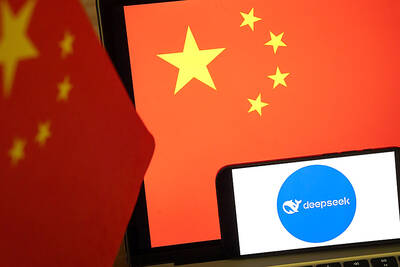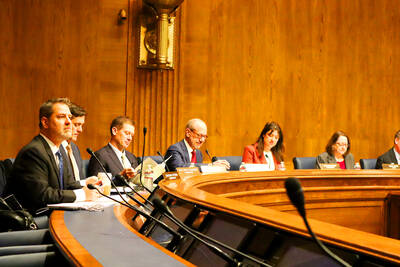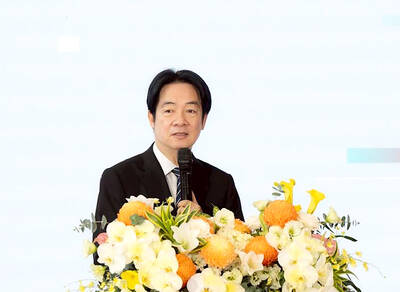In a statement contrary to its repeated stance that Taiwan does not team up with China in defense of sovereignty over the contested Diaoyutai Islands (釣魚台), government officials yesterday recognized the recent display of the Republic of China (ROC) national flag by pro-China activists on the islands.
“We thought that the appearance of the ROC national flag on the islands was in accordance with our sovereignty claims over the Diaoyutai Islands,” Deputy Minister of Foreign Affairs Tung Kuo-yu (董國猷) said.
Tung said he also conveyed that view to Japanese representative to Taiwan Sumio Tarui when he called him in on Thursday to express the government’s concerns over Tokyo’s increasing assertiveness over the Diaoyutai Islands.

Photo: AFP
Japan yesterday deported 14 pro-China activists from Hong Kong, Macau and China, who were arrested by Japanese maritime security officers after they landed on the Diaoyutais, known as the Senkaku Islands in Japan, on Wednesday.
The activists carried with them the ROC national flag, the People’s Republic of China (PRC) national flag, the flag of the Chinese Nationalist Party (KMT) and flags representing the Government of the Hong Kong Special Administrative Region and the Government of Macau Special Administrative Region.
Taiwanese activists did not participate in the action, blaming the government for stopping fishermen from renting them boats.
Under instructions handed down by President Ma Ying-jeou (馬英九) via meetings called by National Security Council Secretary-General Hu Wei-jen (胡為真), the government provided food supplies to the pro-China activists on the Bao Diao II “for humanitarian reasons” en route to the Diaoyutais.
Immediately after the pro-China activists were arrested, the Ma administration called for their release “for the sake of maintaining stability of the region.”
In contrast to its statements targeting Japan for being “oblivious” to the contention over the sovereignty of the islands, the Ma administration yesterday appeared to further sympathize with the pro-China activists.
As well as Tung’s comments, Premier Sean Chen (陳冲) said, in response to media queries, that the government looked at any act staged “purely” to assert Taiwan’s sovereignty over the Diaoyutais “from a positive perspective” as long as the act “was not tinged with other motives.”
Chen added that the best strategy was to advocate the East China Sea peace initiative proposed by Ma on Aug. 5, in which he called for all concerned parties to refrain from antagonistic actions, to shelve disputes on sovereignty and to cooperate on exploring resources.
The ministry said the initiative has received a positive response from Tokyo.
“We came to a consensus to reduce tension in the region. Sumio Tarui also said that President Ma’s initiative was well-received in Japan,” Tung said.
Tung said he told Tarui that the government “knew nothing in advance” about the action taken by the pro-China activists “on their own initiative” and that it had not been involved.
He also told Tarui that the government maintains the position that Taiwan does not cooperate with China in its handling of its claim to the islands.

MISINFORMATION: The generated content tends to adopt China’s official stance, such as ‘Taiwan is currently governed by the Chinese central government,’ the NSB said Five China-developed artificial intelligence (AI) language models exhibit cybersecurity risks and content biases, an inspection conducted by the National Security Bureau (NSB) showed. The five AI tools are: DeepSeek, Doubao (豆包), Yiyan (文心一言), Tongyi (通義千問) and Yuanbao (騰訊元寶), the bureau said, advising people to remain vigilant to protect personal data privacy and corporate business secrets. The NSB said it, in accordance with the National Intelligence Services Act (國家情報工作法), has reviewed international cybersecurity reports and intelligence, and coordinated with the Ministry of Justice Investigation Bureau and the National Police Agency’s Criminal Investigation Bureau to conduct an inspection of China-made AI language

LIMITS: While China increases military pressure on Taiwan and expands its use of cognitive warfare, it is unwilling to target tech supply chains, the report said US and Taiwan military officials have warned that the Chinese People’s Liberation Army (PLA) could implement a blockade within “a matter of hours” and need only “minimal conversion time” prior to an attack on Taiwan, a report released on Tuesday by the US Senate’s China Economic and Security Review Commission said. “While there is no indication that China is planning an imminent attack, the United States and its allies and partners can no longer assume that a Taiwan contingency is a distant possibility for which they would have ample time to prepare,” it said. The commission made the comments in its annual

‘TROUBLEMAKER’: Most countries believe that it is China — rather than Taiwan — that is undermining regional peace and stability with its coercive tactics, the president said China should restrain itself and refrain from being a troublemaker that sabotages peace and stability in the Indo-Pacific region, President William Lai (賴清德) said yesterday. Lai made the remarks after China Coast Guard vessels sailed into disputed waters off the Senkaku Islands — known as the Diaoyutai Islands (釣魚台) in Taiwan — following a remark Japanese Prime Minister Sanae Takaichi made regarding Taiwan. Takaichi during a parliamentary session on Nov. 7 said that a “Taiwan contingency” involving a Chinese naval blockade could qualify as a “survival-threatening situation” for Japan, and trigger Tokyo’s deployment of its military for defense. Asked about the escalating tensions

DISPUTE: A Chinese official prompted a formal protest from Tokyo by saying that ‘the dirty head that sticks itself out must be cut off,’ after Takaichi’s Taiwan remarks Four armed China Coast Guard vessels yesterday morning sailed through disputed waters controlled by Japan, amid a diplomatic spat following Japanese Prime Minister Sanae Takaichi’s comments on Taiwan. The four ships sailed around the Senkaku Islands — known as the Diaoyutai Islands (釣魚台) to Taiwan, and which Taiwan and China also claim — on Saturday before entering Japanese waters yesterday and left, the Japan Coast Guard said. The China Coast Guard said in a statement that it carried out a “rights enforcement patrol” through the waters and that it was a lawful operation. As of the end of last month,